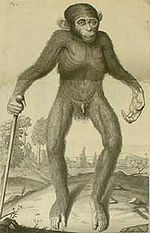- Comparative anatomy
-
This article is about the study. For the experimental drum and bass band, see Comparative Anatomy (band).
Comparative anatomy is the study of similarities and differences in the anatomy of organisms. It is closely related to evolutionary biology and phylogeny (the evolution of species).
Contents
Description
 This picture shows two species, the Common Bottlenose Dolphin (Tursiops truncatus) and the Great White Shark (Carcharodon carcharias). These two species show several analogous structures, such as dorsal fins and streamlined body shape, that give them similar advantages in their environment despite their lack of common ancestry.
This picture shows two species, the Common Bottlenose Dolphin (Tursiops truncatus) and the Great White Shark (Carcharodon carcharias). These two species show several analogous structures, such as dorsal fins and streamlined body shape, that give them similar advantages in their environment despite their lack of common ancestry.
Comparative anatomy has long served as evidence for evolution, it indicates that various organisms share a common ancestor. Also, it assists scientists in classifying organisms based on similar characteristics of their anatomical structures. Comparative anatomy supports Darwin's theory of descent with modification, also known as evolution. A common example of comparative anatomy is the similar bone structures in forelimbs of cats, whales, bats, and humans. All of these appendages consist of the same basic parts; yet, they serve completely different functions. The skeletal parts which form a structure used for swimming, such as a fin, would not be ideal to form a wing, which is better-suited for flight. One explanation for the forelimbs' similar composition is descent with modification. Through random mutations and natural selection anatomical structures gradually became better-adapted to the every organism's respective habitat.[1] Two major concepts of comparative anatomy are:
- Homologous structures - structures (body parts/anatomy) which are similar in different species because the species have common descent. They may or may not perform the same function. An example is the forelimb structure shared by cats and whales.
- Analogous structures - structures similar in different organisms because they evolved in a similar environment, rather than were inherited from a recent common ancestor. They usually serve the same or similar purposes. An example is the streamlined torpedo body shape of porpoises and sharks. So even though they evolved from different ancestors, porpoises and sharks developed analogous structures as a result of their evolution in the same aquatic environment.
The rules for development of special characteristics which differ significantly from general homology were listed by Karl Ernst von Baer (the Baer laws).
History
Born in 1517 Pierre Belon was a French naturalist who did research and held discussions on dolphin embryos as well as the comparisons between the skeletons of birds to the skeletons of humans. His research led to what is referred to as modern comparative anatomy.
Around the same time, Andreas Vesalius was also making some strides of his own. A young anatomist of Flemish descent made famous by a penchant for amazing charts, he was systematically investigating and correcting the anatomical knowledge of the Greek physician Galen. He noticed that many of Galen's observations were not even based on actual humans. Instead, they were based on animals such as oxen.Up until that point, Galen and his teachings had been the authority on human anatomy. The irony is that Galen himself had emphasized the fact that you should make your own observations instead of using those of another. But this advice was lost during the numerous translations of his work. As Vesalius began to uncover these mistakes, other physicians of the time began to trust their own observations more than Galen. An interesting observation made by some of these physicians was the presence of homologous structures in a wide variety of animals which included humans. These observations were later used by Darwin as he formed his theory of Natural Selection.[2]
Edward Tyson is regarded as the founder of comparative anatomy. He is credited with determining that marine mammals are, in fact, mammals. Also, he concluded that chimpanzees are more similar to humans than to monkeys because of their arms.
Marco Aurelio Severino also compared various animals, including birds, in his Zootomia democritaea, one of the first works of comparative anatomy. In the 18th and 19th century, great anatomists like George Cuvier, Richard Owen and Thomas Henry Huxley revolutionized our understanding of the basic build and systematics of vertebrates, laying the foundation for Charles Darwins work on evolution. Until the advent of genetic techniques like DNA sequencing, comparative anatomy together with embryology were the primary tools for understanding phylogeny, as exemplified by the work of Alfred Romer.
Today comparative anatomy is still taught and used, particularly in the field of paleontology.
See also
Footnotes
- ^ Campbell, Neil A.; Reece, Jane B. (February 2002). Biology. San Francisco, CA: Benjamin Cummings. pp. 438–439.
- ^ Caldwell, Roy (2006). "Comparative Anatomy: Andreas Vesalius". University of California Museum of Paleontology. http://evolution.berkeley.edu/evosite/history/compar_anat.shtml. Retrieved 2011-02-17. "Comparative Anatomy, pre-1800s"
References
- Campbell, Neil A.; Reece, Jane B. (February 2002). Biology. San Francisco, CA: Benjamin Cummings. pp. 438–439.
- Caldwell, Roy (2006). "Comparative Anatomy: Andreas Vesalius". University of California Museum of Paleontology. http://evolution.berkeley.edu/evosite/history/compar_anat.shtml. Retrieved 2011-02-17. "Comparative Anatomy, pre-1800s"
External links
Categories:
Wikimedia Foundation. 2010.


